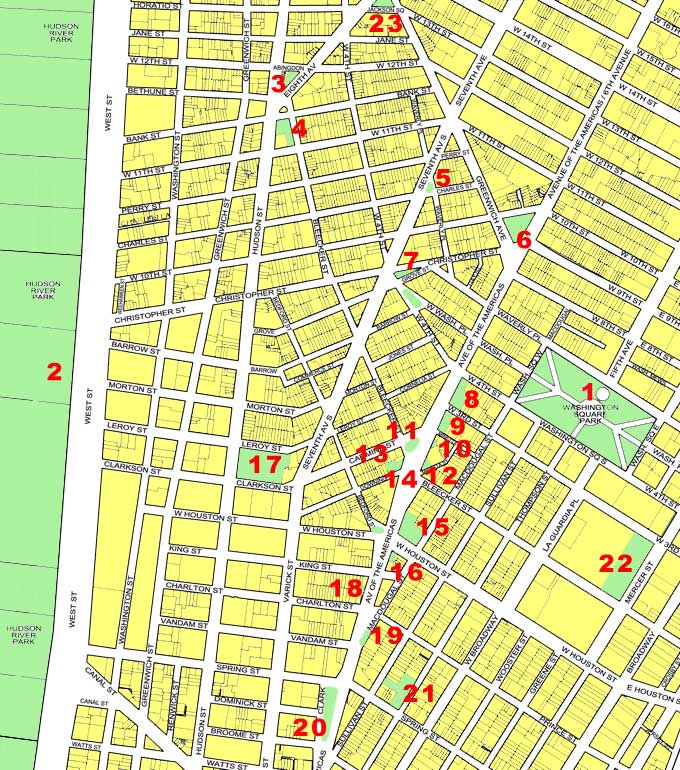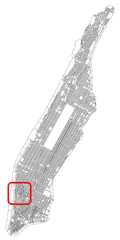|
|
Public Parks and Playgrounds:
The above map illustrates some of the Public Parks and playgrounds within Greenwich Village and Soho. Indicated above, and described below, are a selection of some of the best public parks in the area to relax, walk a dog, read a book or magazine, or simply watch the ever changing parade of people from around the world. Also listed are some of the many playgrounds for young kids.
|
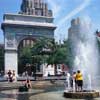 |
1. Washington Square Park
Well-known for its arch, honoring George Washington, the man for whom the park is named, and its fountain, the arch's elder by 43 years and a popular meeting spot, Washington Square Park also houses several other monuments and facilities. Washington Square Park over the years has been a marsh, a cemetery, a parade ground, a gathering spot for avant-garde artists, a battleground for chess enthusiasts, and a playground for canines and children.
|
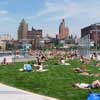 |
2. Hudson River Park
A park in transition. The Hudson River Park is one of New York City's great ongoing projects. It is clear by the thousands of people that frequent the park, that this is a park for the city, tourists, and locals alike. Activities are varied, and start with a jog in the morning, and go on to walking, playing tennis, high wire acrobatics, roller skating, bicycling, etc.. and always a great place to watch the sun set. The Hudson River Park Trust also has many scheduled events. www.hudsonriverpark.org
|
 |
3. Abingdon Square
Abingdon Square Park shares its lineage with some of Greenwich Village's earliest European landowners and social figures. On March 4, 1831 the Common Council resolved that the ground called Abingdon Square should be "enclosed as a public park" and appropriated $3000 "for the expense thereof." The City acquired the parcel on April 22 and enclosed it with a cast iron fence in 1836.
|
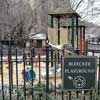 |
4. Bleecker Street Playground
This historic playground, developed in the 1960s, was the first of its kind in the West Village. A great neighborhood spot, the Bleecker Playground features a climbing structure directly on top of the sand pit, in addition to swings and a second, smaller climbing section.
|
|
5. McCarthy Square
In 1943 the Common Council named this site in memory of Private First Class Bernard Joseph McCarthy, who was born and raised in Greenwich Village. A Marine, McCarthy was killed at Guadalcanal in the Solomon Islands in August 1942 at the age of twenty-two. His was the first reported death of a Greenwich Village resident in the war. McCarthy Square's central flagpole originally stood on the grounds of the 1939 World's Fair in Flushing, Queens.
|
 |
6. Jefferson Market Garden
Where some went to market, and some went to jail, today's Greenwich Villagers tend the Jefferson Market Garden in the shade of the landmark Jefferson Market Courthouse. Named for Thomas Jefferson, third president of the United States, the Jefferson Market opened on this site in 1833, alongside a police court, a volunteer firehouse, and a jail. The market grew rapidly to include fishmongers, poultry vendors, and hucksters. It was razed in 1873 to make way for a new civic complex and courthouse.
|
 |
7. Sheridan Square Viewing Garden & Christopher Park
Christopher Park is a small park, and a kind of oasis, at the center of a very hectic area. The Gay rights movement started at this intersection on June 27, 1969, when there was rioting on Christopher Street when police raided the Stonewall Inn, a popular gay establishment, in order to curb liquor law violations. Memorialized in the park are statues of gay and lesbian couples relaxing amongst the benches.
|
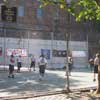 |
8. West 4th Street Courts
The West 4th Street Courts, also known as "The Cage", are a notable public athletic venue for amateur basketball. "The Cage" has become one of the most important tournament sites for the city-wide "Streetball" amateur basketball tournament, and is famous for its non-regulation size. Former NBA player Anthony Mason and current Miami Heat player Smush Parker are some of the nationally recognized ballplayers to learn their tough style of play from The Cage.
|
 |
9. Minetta Playground
In a neighborhood with rather a dearth of play spots, the Minetta Playground, though small, is a godsend. Swings for both older kids and infants, a couple of slides, and a nice green and purple plastic climber/slider set make this a choice spot to expend...a little energy.
|
 |
10. Minetta Green
This small park is a memorial to the one of the lost water features of Lower Manhattan. When Dutch colonists settled in Manhattan in the 1620s, they learned from local Native Americans about a small brook that was full of trout. It originated near what is now Gramercy Square, burbled its way through (mostly beneath) Greenwich Village, and emptied into the Hudson at what is now West Houston Street. Minetta Stream (or brook) now hidden below the streets, still floods occasionally.
|
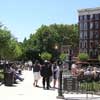 |
11. Father Demo Square
Father Antonio Demo (1870-1936) was born in the province of Vicenza, Italy and came to Greenwich Village and became the pastor of Our Lady of Pompeii, which originally stood a block to the East. In 1923 Father Demo learned that Sixth Avenue (now the Avenue of the Americas) was to be extended from West 3rd Street south to Canal Street for the Hudson River Holland Tunnel then under construction. As in traditional town plans in Italy, Father Demo Square is a piazza - an open space surrounded by buildings and a gathering place for its community.
|
 |
12. Minetta Triangle
This small park is a memorial to the one of the lost water features of Lower Manhattan. When Dutch colonists settled in Manhattan in the 1620s, they learned from local Native Americans about a small brook that was full of trout. It originated near what is now Gramercy Square, burbled its way through (mostly beneath) Greenwich Village, and emptied into the Hudson at what is now West Houston Street. Minetta Stream (or brook) now hidden below the streets, still floods occasionally.
|
 |
13. Downing Street Playground
Legend has it that this land was once the property of Aaron Burr (1756-1836), third Vice President of the United States, and the man who killed Alexander Hamilton in an 1804 duel. The city acquired the original 0.173-acre parcel of land between Downing and Carmine Streets by condemnation in 1896 for use as a school playground. The site was assigned to Parks in 1924 and developed as a children's playground with slides, seesaws, flagpole and portable shower in the mid-1930s.
|
 |
14. Winston Churchill Square
This garden and sitting area was named by Parks in honor of the British Prime Minister Sir Winston Leonard Spencer Churchill, whose official residence, located at 10 Downing Street in London, shares the name of one of the bordering streets. Parks purchased this .05-acre parcel in 1943. The sitting area, designed by George Vellonakis, was rebuilt from 1998 to 1999 to incorporate garden spaces, a pedestal mounted armillary and a decorative, gated iron fence.
|
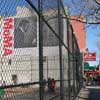 |
15. Passannante Square / Passannante Ballfields
This ballfield is named in memory of William F. Passannante (1920-1996), a lifelong Villager who represented this community in the State Assembly for thirty-six years. The site was acquired by the City for the construction of the Independent Subway whose line curves from the Avenue of the Americas to West Houston Street. The park opened on September 14, 1934. At the request of Community Board 2, the park was named by Commissioner Stern in 1998 to honor the memory of Bill Passannante.
|
 |
16. Playground of the Americas
In 1925, the City of New York acquired this property and transferred it to the Board of Transportation as part of a Sixth Avenue renovation. The Board of Estimate placed the parcel under Parks jurisdiction in May 1934. It remained unnamed until February 1998, when Parks designated it Houston Plaza. In 2000, it was renamed Playground of the Americas.
|
 |
17. James J. Walker Park
The city named it after a New York politician popular in the Jazz Age. As a State Senator, Walker lobbied successfully for the legalization of Sunday baseball and professional boxing, while continuing to work as a lawyer. He socialized with tony Broadway stars and the sports elite. As mayor, he founded the Department of Hospitals, preserved the nickel subway fare, and rooted out corruption in the Police Department and Department of Health. His second term had some corruption & marriage scandals attached! The park has a large playground, but the main feature is the baseball fields & scoreboards.
|
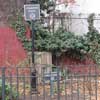 |
18. Charlton Plaza
The plaza is named in honor of Dr. John Charlton (1731?-1801), a celebrated English surgeon who arrived in New York with British troops during the Revolutionary War. The City of New York acquired this property in October 1959 and transferred jurisdiction to Parks in April 1965. Commissioner Stern gave the plaza its current name in 1996, giving the area a well-deserved sense of history.
|
|
19. Father Fagan Square
This park commemorates four local heroes who perished in the face of fire, losing their lives that others might live. Born in Rio de Janiero, Father Richard Fagan (1911-1938) moved with his family to Boston, Massachusetts as a child and later lived in Brooklyn, New York. Located at the Avenue of the Americas, Spring Street, and Prince Street, this sitting area was one of several wedge-shaped plazas developed when Sixth Avenue was extended south of Carmine Street in the mid-1920s.
|
 |
20. SoHo Square
SoHo Square is a wonderful respite for sitting and enjoying the outdoors, despite its proximity to the often hectic 6th Avenue, The Avenue of the Americas. Known of the statue of the Uruguayan independence leader and national hero, General Jose Artigas (1764-1850), it is one of a pantheon of six sculptures to Latin American leaders which overlook the Avenue of the Americas. Soho Square is one of several wedge-shaped public plazas created when Sixth Avenue was extended south of Carmine Street in the 1920s.
|
 |
21. Vesuvio Playground
Vesuvio Playground, formerly known as Thompson Playground, takes its name from the popular Italian bakery on nearby Prince Street. The bakery is owned by community leader Anthony Dapolito and has been family operated since it was founded in 1920. Vesuvio Playground boasts a spray shower, gingko trees, handball courts, basketball courts, boccie courts, and a mini-pool. The on-site bathroom has changing tables.
|
|
22. Mercer Street Playground
Mercer Playground is one of New York's youngest parks, located in one of its oldest areas. Architect Peter Wormser, developed the design concept, which provides play spaces for pre-teens. Features include a long snaked path for in-line and roller skating, a large paved path for running games and bicycling, climbing structures, and a spray shower. A decorative wrought-iron fence, adorned with spirals and silhouettes of familiar objects, unites the three sections of Mercer Playground.
|
 |
23. Jackson Square
One of New York City's oldest parks, Jackson Square Park has a long and somewhat obscure history. The triangular shape of the park is a result of the diagonal route of Greenwich Avenue, the oldest known road in Greenwich Village. It is not clear how, when, or why the site came to be called Jackson Square. Most likely it was named after Andrew Jackson (1767-1845), the seventh President of the United States.
|
|
|
|
